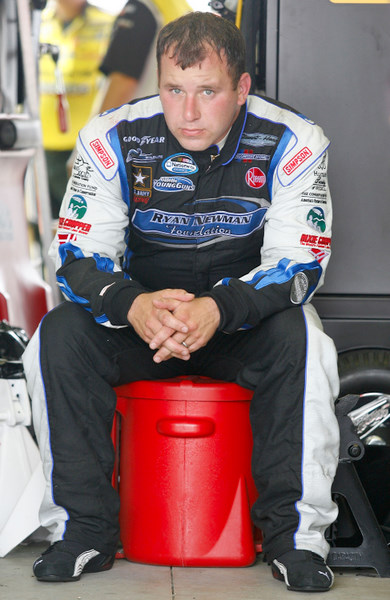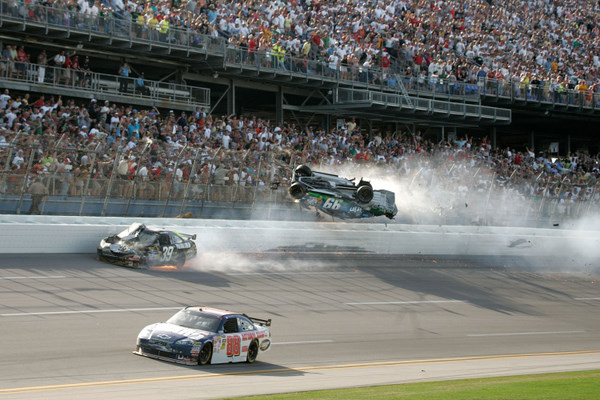Slight aerodynamic changes may be in the works for Talladega and Daytona

Curious: If Ryan Newman has a degree in engineering (Purdue, class of 2001), why isn't he part of NASCAR's Talladega engineering debate? (Photo: Getty Images for NASCAR)
By Mike Mulhern
mikemulhern.net
DARLINGTON, S.C.
NASCAR officials, in response to Carl Edwards' flip at Daytona, are now studying that slight aerodynamic rear spoiler change suggested by Jeff Gordon and Jimmie Johnson, according to one top Sprint Cup team manager privy to the technical debate.
In fact that change might have been tested at Daytona within the past few days, during the 10-team Goodyear tire test for the tour's next restrictor plate race, at Daytona July 4th.
Ryan Newman, whose car got body-slammed by Edwards' flying Ford at Talladega, says the issue is very important for the sport to address.
"I haven't talked to NASCAR, and I haven't been asked by NASCAR about any part of that," Newman said Friday. "I still feel that the biggest thing is to keep the race cars down on the race track.
"If Carl's car wouldn't have got airborne, it would have never got launched up into the catch-fence.
"That, to me, is the primary objective -- to keep the race cars down on the race track.
"The speeds (up to something like 203 mph entering turn three) – that's been a coin-toss for the last 20 years or so. We can talk about that until we are blue in the face. Physics doesn't allow a whole lot of that to change.
"But keeping the race cars on the race track is something that we need to spend time on -- as teams and from NASCAR's standpoint…so we can have safer races for ourselves and for our fans."
Despite the high publicity surrounding the Talladega issue, crews here this week have so far been reluctant to discuss any possible NASCAR changes at the tour's two restrictor plate tracks.
Gordon last week at Richmond, when asked for suggestions about Talladega, in the wake of Edwards' crash, had this to say:
"When we were finalizing this car (COT) at Talladega at the last test we went to several years ago, I always felt like the wicker (that one-inch 'lip' on the rear-spoiler-wing) was a little bit too big for the size of the restrictor plate.
"I'd like to see them consider not just (changing) restrictor plates but possibly something with that wicker too – to not push so much air over the tops of these cars."
That would, Gordon thinks, make for a smaller 'air bubble' behind the lead car.
"Basically that wicker is deflecting so much air that it's put us into that pocket," Gordon says.
"It's just kind of gotten out of hand, so I think there's some things that they can do to slow down that (closing) rate.
"The cars are easy to pass…so you could probably take a little bit (of rear wicker) out and still put on a heck of a race.
"Once we learn something, it seems like we never take it away.
"We might not ever be able to stop this. NASCAR might not be able to stop what we're seeing. Once the drivers learn something, they usually get better at it.
"It's just like going up the middle three-wide. Who would have thought 10 years ago that the middle lane was actually the best lane to get to the front. But now when that green flag drops I go straight to the middle. I don't want to be on the outside or the inside I want to be in the middle."
Goodyear officials said the Daytona tire testing was to improve stability in the draft. Chevrolet drivers Aric Almirola, Mark Martin and Clint Bowyer, Dodge drivers A.J. Allmendinger and Sam Hornish, Ford drivers Jamie McMurray and Paul Menard, and Toyota drivers Marcos Ambrose, Joey Logano and Scott Speed participated in the two-day Daytona runs.
"We tested at Daytona this week because we're continually trying to improve the tire package there," Greg Stucker, Goodyear's Director
of Race Tire Sales, said. "Even though it's a superspeedway of 2-1/2 miles, it requires a good handling package.
"Now that we have more of a history with the car-of-tomorrow at Daytona, we felt like we could give the drivers some more grip and enhance the cars' stability in the multi-car packs.
"The test went very well, and we accomplished a lot over the two days. The teams worked through all the tire combinations we brought, and I believe we've got some good options to review in determining the final tire set-up for July."
However Indianapolis Motor Speedway, where NASCAR will run the Brickyard 400 in July, is another story.
Drivers are worried about Indy.
"It's a tough situation," Newman concedes of Indy. "There are two things -- the Goodyear tires and the surface itself.
"Both of them can point fingers all day long…but the bottom line is it's a big race for us. We have to go up there and put on a good show.
"The situation at the last Indy test (last week) was we started off 'cording' tires (wearing them down to the steel cords) in about the same amount of laps (18 at the 2-1/2-mile track)….and by the end of the day we were not wearing the tires out but they were blistering (from excessive tire heat).
"So there was a sense of improvement…although the final result wasn't there.
"Goodyear has some tests scheduled to go back (in June).
"I think there's still a happy medium -- in finding the left-side and right-side tire combinations, so we're not blistering the rights or cording the rights.
"We're still not optimized, I feel, as far as the left-side tires themselves.
"I think that eventually we'll get it. But that surface is so abrasive it's hard to find that happy medium."

The Talladega backflip that Carl Edwards really didn't anticipate (Photo: Getty Images for NASCAR)
© 2010-2011 www.mikemulhern.net All rights reserved.
Web site by www.webdesigncarolinas.com







Gordon's suggestion is dumb.
Gordon's suggestion is dumb. To take even some draft away from the cars is simply dumb because it's the draft that makes passing possible. When the old 1980s cars got so aero-clean that the draft's bubble was reduced to about one length long, passing largely disappeared, not coming back until NASCAR began increasing spoiler sizes and angles.
This is the exact same argument - "the rate of closure is too great" - made in 2001 with the roof spoiler package. Sterling Marlin in particular was screaming about it after the EA 500 in October 2001; two years later in the same race he went on TV and MRN and advocated NASCAR bring the roof spoiler package back, "dangerous rate of closure" and all, because they can pass with that package.
This is why I shake my head when drivers advocate changes like Gordon is doing - it's two-faced and wrong. The wrecks are happening because drivers are not holding their lines properly. NASCAR can't police that - we've seen them try for years - so drivers at some point have to just admit that this is what racing is and to just focus on winning the race.
NASCAR should mandate a smaller plate for July because trap speeds of 205 were seen at Talladega.
Post new comment